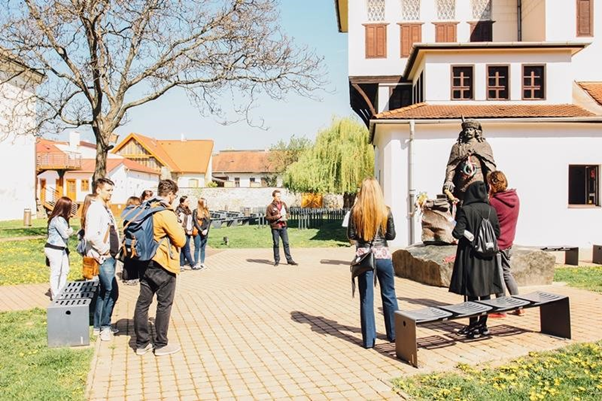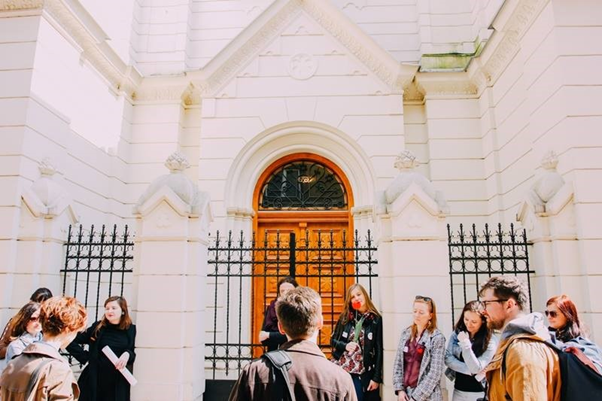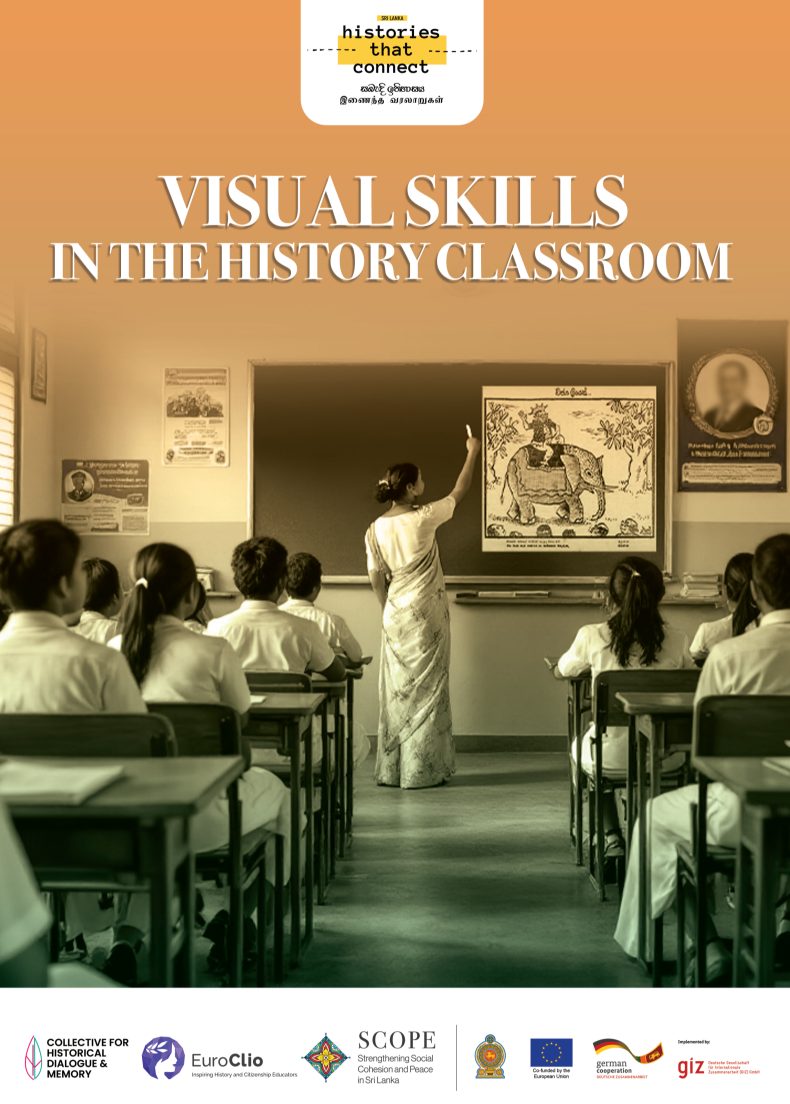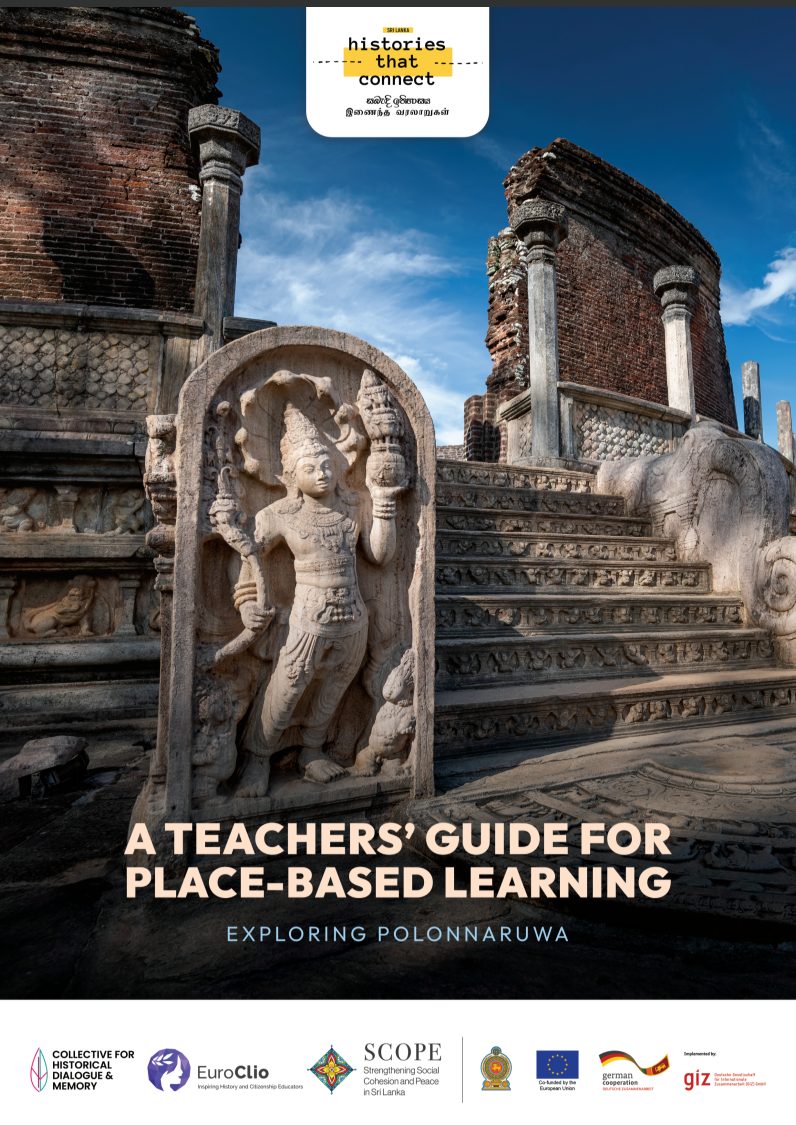By Tatiana Birešová and Juraj Varga
Inspiration
The reality is that, today, students can find almost all information they need for their history lessons online. The confrontation with modern technologies forces the history teacher to think about using non-traditional teaching methods. Juraj and Tatiana believe that their Historical Workshops project can provide a solution, providing advice, suggestions and a method for using the public space in the teaching of history.
Introduction to the Practice
This teaching practice is part of a larger initiative on the development of Historical Workshops in the public space and was developed and published as part of the initiative 'History teaching in the 21st century' for the Department of Education at the Institute for the Study of Totalitarian Regimes in Prague (website in Czech). In essence the teaching practices takes the public space available to the teacher and students as a starting point, with focus both on the use of larger structures such as squares or smaller ones such as statues, specific buildings, or memorial plaques. An empty space can also be interesting: perhaps there was a statue or a monument there in the past, or perhaps it served as an important place for social events.
This specific workshop was designed for Košice, the second largest city of Slovakia, but the two authors point out that every city hides the potential for its "discovery" – whether large or small. The workshop should in other words be seen as a template or a proposal for a blueprint, providing inspiration for educators wanting to do something similar in their own environs.
❝There are essentially two pathways. Either you know an interesting place in your city and you want to use it somehow for your workshop, and as a result you adapt the goal to this place, or on the contrary, you have an idea at the beginning of what you would like to achieve with the workshop and then you try to find places in the public space of the city that would suit you. Neither path is a priori correct and you might end up somewhere between these two approaches.
Applying the Teaching Practice
Designing a workshop for the city of Košice, Juraj and Tatiana included five locations: the Monument to the soldiers of the Soviet Army, the Orthodox synagogue, the statue of Sándor Márai, the chapel of St. Michael and the statue of Francis II. Rákoczi. Below follows a short description of three of the locations and the author's ideas and rationales for their inclusions in the tour.
Statue of Francis II. Rákoczi

Francis II. Rákoczi is an important historical figure who is connected with the history of Košice. This very fact, but also that his statue is located in the city centre and next to the memorial house dedicated to him, played a role in the decision to choose this place for the needs of our workshop. The personality of Francis II. Rákoczi for the purposes of historical teaching hides several layers. It is associated with the anti-Habsburg uprisings, through which it is possible to interpret regional developments. One may also use its so-called secondary importance in explaining the nationality question of the 19th century.
Juraj and Tatiana chose to use the entire life story of Francis II. Rákoczi as a 'window' into the history of the 17th century – both regionally but also connections with world history.
Target age group: 13+
Time : 45 min
Didactic medium used: biography
The goal: In almost every city, you can find a person who had a regional, even European or global significance. It is such personalities that offer space for connecting regional and national or of general history.The aim of this place was to think about the possibilities of using the concept of biography in the teaching of history. Among the questions asked were, for example: How can biographies be used for teaching history? Is it possible to combine the interpretation of national and local history, which is often too strictly separated, through biographies of life stories of individuals?
On-site activity: At the designated place, a sketched timeline of the life of Francis II Rákoczi awaited the participants. The first task was for the participants to write in this timeline various events (regional, national, world) that they remembered and which took place in the given time frame. This led to a highly diverse record of events. Discuss with students whether the chosen biography can serve as an example in explaining a specific historical period and how does an experience of an individual relate to broader historical themes.
Orthodox Synagogue

In the public space, the synagogue building is a useful associative element for analyzing the relations of majority and minority groups in society, for presenting the history of Judaism in the given region, as well as for teaching the topics of the Second World War and the Holocaust.
Target Age Group: 13+
Time : 45 min
Didactic medium used: video clip
Goal : The goal is to analyse the way in which the status of Jewish people is interpreted in the context of history, whether in history classes or directly in the public space. The workshop hosts did this by showing a video clip of a well-known Košice tourist guide, exploring topics related to Jews of Košice and Judaism in the city in different historical periods (and, crucially, not only in the context of the Second World War) within the school history curriculum.
On-site activity: In the introduction, Tatiana and Juraj used a prepared video clip from one of Milan Kolcún’s walking tours. Kolcún is a local tourist guide and in the tour he presents his perspective on the presence of Jewish people since the 19th century. After this, Juraj and Tatiana presented their participants with a number of questions. In what ways does the video signify the experience of the Jewish community during the 19th and 20th centuries? How did religious (or other) minorities manifest their presence and beliefs in the public space?
Monument to the soldiers of the Soviet Army

This monument has already become a relatively insignificant element in the current layout of the city’s public space. The choice of this place was related to a large number of thematic possibilities for its use in history education. They are, for example: the Second World War, the post-war arrangement, the rise of communism, everyday socialism, normalization, and the functions of the monument as a whole to commemorate the event.
Target age group: 13+
Time: 45 min
Didactic medium used: public space
Goal: Our aim was to explore the possibilities, approaches and perspectives by which this monument can be used in the teaching of history. This time, the creators of these possibilities were the participants themselves, so that they could try for themselves what the preparation of a history class structured in this way entails.
On-site activity: Immediately after arriving at the site, participants were presented with basic factual data about the monument. Subsequently, three groups were formed and the task of each of them was to think over the topic of the history lesson, within which they would use this particular monument: Think about the use of this monument in the classroom, in a lesson or in activity. What theme/part in the curriculum you would connect it to? You have to describe and define the structure of the lesson/activity. You can use printed out visual sources and pre-curated sources stored in the tablets provided. Individual groups presented their proposals to each other. All three demonstrations were followed by a discussion about whether what one group presented was stimulating for the other groups, or what they would do differently and why.
Useful Tips
Juraj and Tatiana have identified several steps for educators wanting to establish a historical workshop in the public space. At the beginning, it is important to choose the place where the workshop will be held and to set clear goals or learning objectives.
The aim of the workshop may be to present a certain historical period, to deepen knowledge through alternative teaching methods, to repeat a certain subject matter, or to present a different view of history than the one presented in textbooks. What is important is that the goal you set should be tailored to your chosen locations.
In the process of selecting locations, in addition to finding and studying relevant literature and sources, it is advisable to contact local institutions that could have additional information for the project. These include local archives, institutes, libraries, or associations. It is also a good idea to find out if, for example, there is research or a project done at the local university. Addressing local institutions is beneficial from several points of view: you will get a lot of information about the place, you will deepen your knowledge of the historical events that took place and in the process, you will likely also make connections with interested individuals, many of whom you can subsequently ask for help and advice in hosting your workshop.
A workshop in the public space can zoom in on a single space or align several stops along a route. If you decide on the second option, i.e. you choose several places, it is important that when compiling the route, you make sure that the individual places connect to each other logically, content-wise, and didactically. The correct order of places (and activities there) will support the final goal of the given workshop. Each place should make sense on its own, but also in the context of all the others. It is advisable that the tasks at individual locations are varied, and that their didactic focus is refined and clear. The workshop as a whole will not appear chaotic and self-serving, but will have a more compact character.
Before you go with the participants of the workshop along the predetermined route, go through it yourself, in the order in which you have conceived it and with all the activities. Thanks to this step, you will have the opportunity to at least partially take on the role of a participant. In addition to verifying whether the order of places, as you determined it, is truly logical, you will also have the opportunity to take into account practical aspects, such as the noise level of the space, the safety of the space in terms of public transport, the possibility of distributing or seating the participants, or whether the time you reserved for individual places is sufficient.
Obstacles and Lessons Learned
- Designing a workshop around the public spaces of the city where you live is an inspiring way to connect students with local, regional, and often European and world histories. The specific focus of the workshop can be easily tailored to what exists in the city or neighbourhood of a school. Most European cities will have a number of potential sites where you can uncover multifaceted layers of history.
- Designing a workshop around a public space is a complex endeavour, requiring time and research skills. Students can to some extent be involved in the research aspects, however much will depend on the teacher and local support networks (e.g local museums, tour guides, associations, universities, etc.).
Conclusion
The authors present a concept for the creation and implementation of a historical workshop, making use of the public space in the teaching of history. Creating such a concept for a workshop is complex. The authors offer a framework of basic steps that are meant as recommendations for educators wishing to create a workshop in their own public space.
- Choice of city and setting of the key goal, ie. what we want to achieve with the workshop
- Selection of specific places
- Creating a route, ie. a logical arrangement of places in a row that corresponds to the set goal
- Route testing
- Consideration of necessary adjustments
- Realisation of the workshop
Based on Juraj’s and Tatiana’s experiences, they offer a couple of additional tips:
- As a starting point, verbalise expectations of the tour
- Keep the agreed deadlines
- Take a human, not managerial approach
Additional Resources
This teaching practice was originally published on www.dejepis21.cz (page mainly in Czech, with certain pages in Slovak), where more details are available along with descriptions and examples of workshops in other cities in Slovakia and Czechia.
The Contested Histories project, jointly run by the Institute for Historical Justice and Reconciliation and EuroClio, provides an overview of disputes over statues, street names, and other historical legacies in public spaces all across the world. It can be a useful source of inspiration for locating sites near you.
About the Authors
Tatiana Birešová
Tatiana studied history and pedagogy. As part of her studies, she focused on the issues of recent Czech and Slovak history, the issue of national identity and the issue of nationalism and its manifestation in public space. She also dealt with the issue of integrated thematic teaching, specifically in the field of social sciences, and its possibilities of use in contemporary education. She has been working in the field of education since 2015. In 2017, she co-founded with Juraj, the NGO “Center for Education and Innovations”, in which she regularly participates and leads methodological seminars for history and civics teachers. Since 2020 she has been working as a methodologist in the project “History, Society and Culture of the 20th Century in the Digital Resources of the MKC Library”, which results in the creation of interactive pdfs. and online individual activities.
She has participated in multiple international projects for example „Who were the victims of national socialist“ project coordinated by Euroclio or project „Exploring the past in the present“ led and coordinated by The Institute for the Study of Totalitarian Regimes (Czechia).Currently she works as a history and civics teacher.
Juraj Varga
Juraj, trained as educator and historian, focuses on development of learning and teaching materials and development of teacher training programs on regional, national and European levels since 2014. Juraj loves to work with teachers and for teachers, support them and to create professional development opportunities for them. He founded the NGO Centre for Education and Innovations in Slovakia in 2017 and acts as its Chairman, cooperates with The Institute for the Study of Totalitarian Regimes (Czechia) on teaching about state socialism and acts as one of three Pedagogical Advisors for Holocaust as a starting point, teacher training program running in 26 countries around Europe by Mémorial de la Shoah (France). Juraj harvests data and researches about the use of the materials and programs developed. He is highly interested in communication, memory and propaganda studies, psycholinguistics and sociolinguistics.
Contact
For further questions or enquiries, Juraj Varga can be reached by email (juraj@cedin.sk).
* This teaching practice was originally published in the Slovak language on www.dejepis21.cz and translated to English as part of the collection of teaching practices for the Critical History project with co-funding of the Erasmus+ Programme of the European Union.
The European Commission’s support for the production of this publication does not constitute an endorsement of the contents, which reflect the views only of the authors, and the Commission cannot be held responsible for any use which may be made of the information contained therein.





